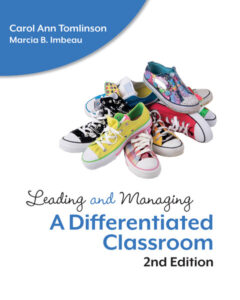All the Tools You’ll Need for Differentiation
Leading and Managing a Differentiated Classroom, Second Edition
By Carol Ann Tomlinson and Marcia Imbeau
(ASCD, 2023 – Learn more)
Reviewed by Cathy Gassenheimer

Pondering the enormity of the task to support these new teachers, with little or no training in pedagogy, I remembered what the director of this coaching program said:
“It’s essential that these underprepared teachers have a heart for children. If they have that, we can teach them how to be effective teachers.”
These teachers are supported both by zone coaches and school-based instructional coaches. They also participate in district-wide professional learning designed to deepen their knowledge and use of effective instructional strategies. This is the “learning the job on the job” reality many school systems are facing across the nation.
Surfacing a Resource

I was thrilled when I received a copy of the second edition because I LOVED the first version (2010). Looking at my old copy, the proof of my love is in the annotation throughout and the memories of the professional learning workshops I designed.
A Look Inside
Although any teacher can find valuable insights in this wonderful book, Tomlinson lets readers know in her engaging preface that it is written especially with new and novice teachers in mind.
The new edition is divided into two parts. The first part provides the rationale for differentiation. In the preface, Tomlinson makes this important point:
An effective teacher is not someone who just teaches content. An effective teacher is someone who teaches content to distinct human beings, and the classroom has to work in such a way that each individual in it has a legitimate opportunity to grow as much as possible from their starting point” (p. 10)
While I’m not a mind reader, I imagine those of you reading this are thinking: “Wait a minute. These teachers in Alabama need basic classroom management skills first. And you’re talking about differentiation?”
My answer to that wondering is a loud YES, for two reasons. First, new teachers have the responsibility to do their very best for each student they serve. They don’t need to fall into bad habits like long lectures, the use of worksheets, and answering questions at the end of a chapter in a textbook.
Instead, they need to consider why they chose to teach and what their responsibility is to students in their classroom. To help this pondering, the authors delineate five belief systems undergirding an effective classroom (pp. 46-56):
Belief 1: Every student has inherent dignity and is worthy of respect.
Belief 2: Diversity is both inevitable and positive.
Belief 3: The classroom should mirror the kind of society we want our students to live in and lead.
Belief 4: Most students can learn most things that are essential to a given area of study.
Belief 5: Each student should have equity of access to excellent learning opportunities.
The authors accompany each belief system with a series of reflective questions. As an example, I’ve captured some of the questions for Belief 1: Every student has inherent dignity and is worthy of respect (pp. 46-47):
► How can I gain an understanding of the particular cultures, talents, strengths, interests, needs, burdens, and dreams this student brings to the classroom daily?
► In what ways can I show this student that I unconditionally value them?
► How do I help this student recognize and extend their strengths?
► How can I guide development of a sense of classroom community and collaboration characterized by empathy and respect?
Step-by-Step Suggestions
The second reason I say “yes” to this book for new teachers is because Part Two provides specific details about how to manage a differentiated classroom, with suggestions and examples at both the elementary and secondary levels. The chapters are titled:
Chapter 4 – Learning Environment: Setting the Stage for Academic Success
Chapter 5 – Classroom Routines: Preparing for the Work Ahead
Chapter 6 – Routines in a Differentiated Classroom: Once the Work Begins
Chapter 7 – Yes, But…Common Sticking Points About Differentiation
In other words, Part Two of this book is a “how-to primer” for any new teacher, whether university-prepared or on an emergency certificate. The authors start with the basics: routines, classroom norms, starting and ending the class or the day successfully, assigning students to groups, and how to give directions for multiple tasks.
Part two continues with tips for engaging all students, effective group work, managing noise, helping students develop strategies for asking for help, managing transitions, and managing time.
Finally, the book ends by responding to the fears and concerns of teachers who have never differentiated. I remember one secondary teacher saying, with tears in her eyes, “I’d lose control if I used small groups!” I wish I’d had a copy of this book then to give her. As we all know, discipline issues decline when teachers establish classroom routines and engage all their students. It takes courage – and strategies like those outlined in this book – to try differentiation.
A Useful Resource
The next day after my work with the secondary coaches, I called their leader and suggested this book as one tool for the teachers on emergency certificates, acknowledging the caveat and final word from the authors:
It’s not our expectation that teachers can read a book, flip a switch, and magically transform their teaching. Rather, we believe that there are teachers who aspire to understand the art and science of teaching a little better each day, who are willing to take the risk of confronting the effectiveness of the work they do in the lives of each student in their care, and who are courageous enough to make small and large decisions each day based on benefits to their students – individually and as a whole” (p. 186).
There’s no better moment than now to help new teachers start off right, knowing that it will take time to perfect their practice, but it will be worth it when they watch their students soar.
Cathy Gassenheimer is a professional learning consultant specializing in collaborative adult learning and collective efficacy. For 22 years she was Executive Vice President of the Alabama Best Practices Center, a program of Alabama’s statewide nonprofit A+ Education Partnership, and led the work of three statewide educator networks focused on teaching, leadership, and instructional coaching. Connect with her via LinkedIn and on X-Twitter @cathygassenheim.





























